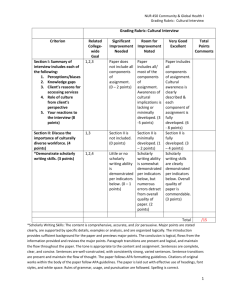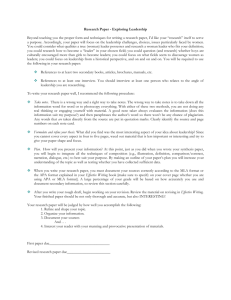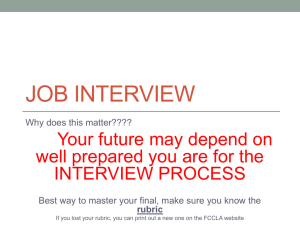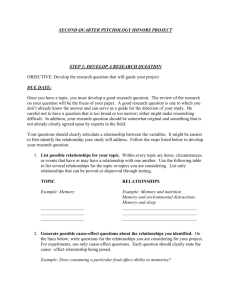4_Final Researched Paper
advertisement
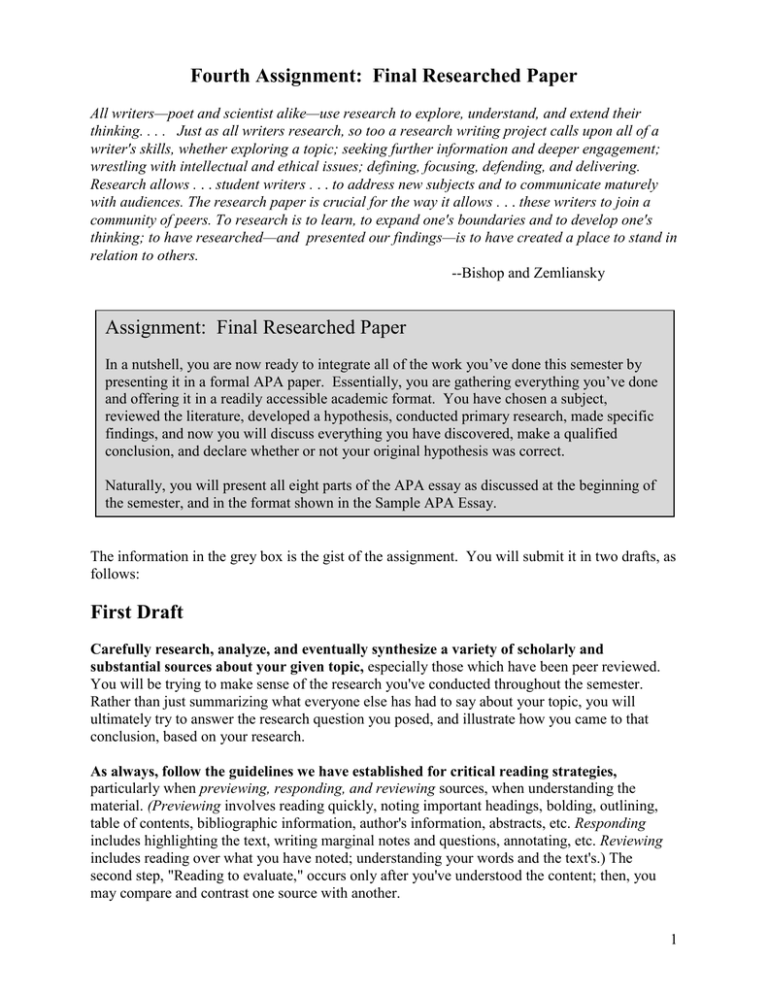
Fourth Assignment: Final Researched Paper All writers—poet and scientist alike—use research to explore, understand, and extend their thinking. . . . Just as all writers research, so too a research writing project calls upon all of a writer's skills, whether exploring a topic; seeking further information and deeper engagement; wrestling with intellectual and ethical issues; defining, focusing, defending, and delivering. Research allows . . . student writers . . . to address new subjects and to communicate maturely with audiences. The research paper is crucial for the way it allows . . . these writers to join a community of peers. To research is to learn, to expand one's boundaries and to develop one's thinking; to have researched—and presented our findings—is to have created a place to stand in relation to others. --Bishop and Zemliansky Assignment: Final Researched Paper In a nutshell, you are now ready to integrate all of the work you’ve done this semester by presenting it in a formal APA paper. Essentially, you are gathering everything you’ve done and offering it in a readily accessible academic format. You have chosen a subject, reviewed the literature, developed a hypothesis, conducted primary research, made specific findings, and now you will discuss everything you have discovered, make a qualified conclusion, and declare whether or not your original hypothesis was correct. Naturally, you will present all eight parts of the APA essay as discussed at the beginning of the semester, and in the format shown in the Sample APA Essay. The information in the grey box is the gist of the assignment. You will submit it in two drafts, as follows: First Draft Carefully research, analyze, and eventually synthesize a variety of scholarly and substantial sources about your given topic, especially those which have been peer reviewed. You will be trying to make sense of the research you've conducted throughout the semester. Rather than just summarizing what everyone else has had to say about your topic, you will ultimately try to answer the research question you posed, and illustrate how you came to that conclusion, based on your research. As always, follow the guidelines we have established for critical reading strategies, particularly when previewing, responding, and reviewing sources, when understanding the material. (Previewing involves reading quickly, noting important headings, bolding, outlining, table of contents, bibliographic information, author's information, abstracts, etc. Responding includes highlighting the text, writing marginal notes and questions, annotating, etc. Reviewing includes reading over what you have noted; understanding your words and the text's.) The second step, "Reading to evaluate," occurs only after you've understood the content; then, you may compare and contrast one source with another. 1 Your paper will follow the basic guidelines below, using APA documentation style: A formal title page will be required, following the examples used in class and in your reference text. This will consist of a running head (an abbreviation of your title) listed on both the title page and all subsequent pages. Your last name will no longer appear in the upper right hand corner. An abstract will appear after the title page, which will be the last formal writing you will do for the paper. This abstract will be your summary of your paper, and will follow the basic guidelines suggested by me and your reference text. It will be one paragraph long of approximately 100-150 words. Details will follow. The text of the paper will include four separate headings: (1) Introduction, (2) Methods, (3) Results, and (4) Discussion. (1) The Introduction will provide introductory information about the topic and issue, along with any relevant history, background, and so on. You might use a definition or explanation of the issue, causes and effects, and an appropriate lead-in, given your knowledgeable audience. You will establish the importance of this issue to those in an academic and/or professional field. Included in the Introduction will be a Review of the Literature, a rewriting of five of your scholarly journal articles summarized in Paper #2. You will briefly summarize each source's contribution to your discussion of the topic. Instead of alphabetizing these summaries and isolating them as you did in Paper #2, you will organize them logically and synthesize them where appropriate. (A separate handout will explain this part of your paper more fully later.) Your hypothesis statement will conclude the introduction of the paper. This will be a “what if” or “whether or not” sentence about what you intended to do as you began this writing project (a revision and restatement of your research question). The above items under (1) will be your 1st draft; your second draft will include a revised Intro, plus #’s (2), (3), and (4) below, with (5) the References Page. Second Draft (2) The Methods section of the paper will come next and will also be headed separately. In it you will describe how you obtained the primary information (probably the same two sources you used for Paper #3). This will be a very brief explanation of the process by which you obtained both primary sources, including the dates, places, and other specifics about your research process. (3) The third section, will be labeled Results, in which you will summarize the content of the primary research. This will be a version of your primary research paper. (4) The last labeled section, Discussion, will summarize and synthesize what your sources have indicated to you. This will undoubtedly be the most important part of the project, in 2 that you will come to some overall meaning about what this issue has meant to you as a researcher. You will interpret how your primary research related to your secondary (scholarly) and other sources. This connection between the major findings will be the focus of this part of your paper. In it you will try to make three or four important points you have discovered about your topic (as you were trying to answer that research question) and use your sources to support those points. You needn't summarize all eight sources here—only those significant ones you found most beneficial to your conclusions. (5) A References Page will conclude your researched paper. You will follow the basic principles established by APA, as summarized in your reference text, or any of the additional sources already recommended to you. Bear in Mind the Following: Purpose and Audience Your purpose in this assignment is to both review the substantial research that has been done on this issue, and to report on your own primary research, reaching an overall conclusion about what that research has found. Your overall point will be to answer your research question you posed. Your audience will be educated and knowledgeable researchers in the field (possibly scholars) who will have experience with the topic and understand both the fundamental and specific information about the topic. (Graduate students may also be considered.) You should try to create a “real” audience, perhaps professionals in the field, who will be able to both understand and appreciate your research. Sources 1. You will need to cite a minimum of eight sources: Five (5) must be scholarly journal articles, Two must be primary sources, including the surveyor interview 2. The remaining source must be at least a substantial source of some kind. (This source could be your sixth scholarly source from the Annotated Bibliography assignment or a substantial source from Paper #1.) Be cautious about any Internet source used, however, and evaluate its credibility and relevance based on our classroom discussions. At least one personal one-on-one interview or personal survey is required for this semester-long assignment, as a primary source. Perhaps you conducted an extensive interview of someone considered an expert or authority in the field for your Primary Research Paper. If needed, review the strategies listed on the "Interview" handout concerning what to do before the interview, during the interview, and after the interview. All prewritten questions and subsequent answers from the interview must be submitted in your final folder, as part of your required sources. If you've done a survey, you'll need to include all thirty (30) of the completed surveys in your folder. 3 3. 4. As you review your sources for this paper, consider whether all eight (8) are directly related and relevant to your research question or focus. Be sure to re-read each source, this time looking for common threads or relevance. If all are not relevant, etc., you may substitute any source with another, better source. If you have questions about the credibility of these new sources, particularly if you substitute any scholarly journal articles, check with me. These sources should be recent (preferably published within the past five years), relevant (pertinent to your argument and topic), and reliable (taken from credible sources). You may use a dated source for background information or comparative purposes, however. Length and Format 1. 2. Your paper should be at least 8-10 full pages of text, double spaced (with regular 1" margins), plus the title page, abstract, and a References page. You may, as always, write more than the required length (but, please, no more than fifteen pages!). Graphics, tables, charts, appendices, or any other visuals may be used as part of your essay's discussion, but are not required. Consult me about the use of footnotes or endnotes, if applicable. Your Researched Paper Should Meet the Following Criteria: 1. 2. 3. 4. 5. 6. 7. 8. The introduction effectively engages and informs the reader about the topic and subsequent issue. A concise Review of the Literature will constitute the bulk of your introduction. An analytical hypothesis has been stated in the introduction of the essay, indicating your overall claim(s) about the issue or the scientific question you are hoping to prove. The paper includes the list of required items for an APA paper and is logically organized within each heading. Each of the four headings have been clearly and thoroughly examined and defined by the writer. The following strategies have been used: (a) Summarizing: As exemplified in your review of the literature, (b) Analyzing: A careful examination illustrates how each source has presented its information and contribution to this field of study, and (c) Synthesizing: Sources have been blended and related to one another. Recent, relevant, and reliable sources have all been used to substantiate your overall aims and conclusions. These sources include both primary sources and secondary sources. All sources have been correctly cited and documented according to APA style, using a combination of summarizing, paraphrasing, and direct quoting. Remember that few direct quotes are recommended in APA, and only direct quotes are generally accompanied with corresponding page numbers. Your language and style is appropriate for a researched paper, written for an educated and knowledgeable audience. Your academic and researched “voice” is apparent and a reflection of the semester-long research you have conducted. Active voice is dominant but passive voice can be used, if appropriate. First person may be used, where appropriate. Your title and abstract reflect your overall claims and conclusions accurately and succinctly. 4 9. The writing project contains the following items and is reflective of the research process: Third and final draft Second draft (instructor reviewed) First draft (peer reviewed) All eight (or more) full-text sources in alphabetical order Annotated bibliography Source: Mark Spalding, based on a handout by Karol Dehr (2009). 5

